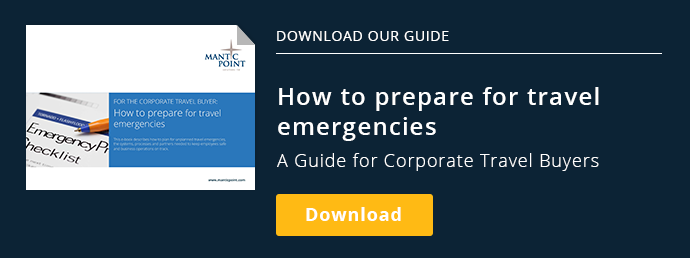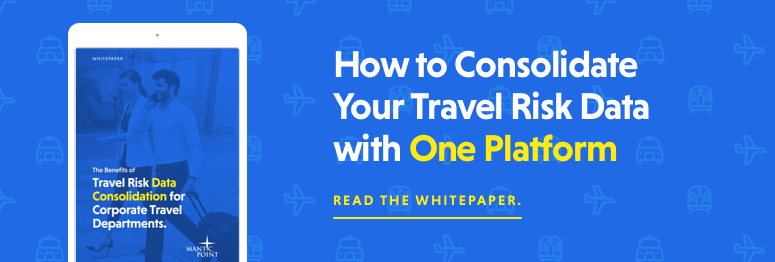How Does Data Aggregation Boost Travel Risk Management?
Posted by Mike Atherton on 05 July, 2018
.png?width=750&name=Mantic%20Point%20(1).png)
According to International SOS and Control Risks, two of the travel industry's foremost medical and security experts, the demand for advice on supporting business travellers has grown almost 300% in the last two years alone. And 800% over the last decade. Can data aggregation help fulfill this need for more and better travel risk management (TRM)?
Travel management companies (TMCs) are nothing if not innovative, and the industry has risen to meet this challenge head on, armed with bigger and better travel risk management software. Of course, this is the age of big data and some of the greatest developments have involved pioneering new methods of using traveller data.
The Problem with Business Traveller Data
From online booking tools and sharing economy apps to corporate credit card receipts and traveller itineraries, employees create a colossal amount of data during a business trip. Immense stockpiles of information sound great, however, most organisations simply don’t have the ability to collect, sort and analyse data, unless it comes from a very narrow selection of sources.
For example, while sharing economy services like Uber, Lyft and Airbnb are gaining in popularity with travellers, this can be problematic for TMCs or corporate travel departments. Simply put, many travel management systems weren't designed to interact with third-party apps, so the details of any bookings made through them aren't captured.
Similarly, the solutions used by many TMCs don’t have traveller-friendly mobile versions and so travellers use more convenient mobile platforms. Again, the opportunity to gather trip data is lost.
When you don't have an accurate record of when and where employees are travelling, TRM becomes a nigh-on impossible task. And, with more and more business travel booking platforms being created by third-parties, it becomes vital for TMCs to be able to capture and analyse data from disparate channels.
The Menace of Off-Policy Business Travel
To help combat the obvious gaps in their data, companies sometimes create strict corporate travel policies in an attempt to funnel all bookings through their internal system.
Obviously, this makes it far easier to collect data and better manage travel risks but many travellers still choose to simply ignore these policies. Whether you work in-house for a corporate travel department or as an outsourced specialist travel manager, we're sure you're familiar with the menace of off-policy bookings.
For some organisations off-policy bookings actually outnumber those made following corporate guidelines, and the average travel manager has to contend with bookings made directly with suppliers, trip changes made during travel, sharing economy elements and the use of a multitude of third-party apps. The increasing popularity of bleisure travel is also proving problematic, throwing up all kinds of questions about where businesses's duty-of-care begins and ends.
With typical TMC software data-streams not capturing bookings from these channels, the best-case scenario is the laborious task of tracking down the trip details and entering them into your system manually. This is not only time-consuming, but humans are obviously far more fallible than machines and it can be especially confusing if your data provides different values for the same field.
More often than not, business trips booked off-policy often simply fly under the radar, leaving employers with little understanding of where their employees are and travellers uninformed of the risks inherent with their travel.
Companies then have a choice, they can either enforce stricter and more rigid business travel policies or they can embrace new channels for booking business travel. Of course, the latter will require a commitment to finding a solution to capture data from these disparate sources.
The Power of Data Aggregation
Data aggregation is, in essence, collecting data from a range of different sources, removing any information which isn’t useful and then presenting the data in an easy to understand format.
This can be extremely simple, and most TMCs already aggregate data from their travel management software and HR systems. On the other hand, some corporations pull data from millions of disparate sources at once.
In fact, the only limits to data aggregation are the number of sources your systems can extract data from, the intelligence of the software you use and the processing power you possess.
It’s extremely likely that the future of TRM will be rooted in facilitating greater interaction between disparate apps or programs, alongside developing software that reads a wider range of data formats and translates them into a single format commonly used by TMCs.
For now, while it’s still rare for travel managers to make the most of external data sources, we are seeing a trend emerging of information being pulled from social media posts or credit card transactions to create a more well-rounded view of what a traveller is doing and where they are.
More Reliable Traveller Tracking
Traveller tracking is a now a commonly element in TRM, with the ready availability of GPS-enabled mobile devices empowering TMCs to offer comprehensive solutions. However, while these are considered fantastic tools for business travellers, especially those in high-risk locations, there are concerns over privacy and a need for better opt-out TRM functionalities..
Data aggregation provides a useful solution for travellers who desire a less intrusive TRM tool, as it can consolidate data from a range of sources across a business to develop a better understanding of where travellers are. For example, not just drawing data from an itinerary to see where a traveller should be, but also from social media, credit card swipes, and expense reports to see where they actually are.
Better Risk Management Information
Data aggregation has also revolutionised the way that TMCs and corporate travel departments approach pre-trip travel risk briefings. Instead of relying on their own research, close to a third of travel managers surveyed by BTN use external TRM partners to use data aggregation to collect travel risk data from a massive range of sources to create an extensive view of travel risk at any specific location.
TMCs that want to improve the level of travel risk information provided to their travellers will therefore need to either develop their own software or work with a partner to constantly monitor risk-related events, capture and analyse relevant information, before reporting any insights directly to travellers.
Using data aggregation to enhance the travel risk information you have is quickly becoming a tried and tested method for improving TRM offerings.
Adding Value to Your TRM with Data Aggregation
For TMCs who are quick to get ahead of the curve, data aggregation provides an opportunity to set themselves apart from their competitors.
If you have the technological know-how, creating proprietary software that’s able to draw from various data sources to provide better TRM will help elevate your offerings. Otherwise, there are several third-party solutions that have been developed to imbue your organisation with more comprehensive TRM tools.
Of course, it isn’t simply enough to provide solutions that aggregate data, you’ll also need to deliver information to clients in a way that is clearly useful – the difference between selling information and insight.
The true value of any data isn’t necessarily in the information itself but what it means to the end-user. For travel managers this might be TRM map interfaces or dashboards that show exactly where business travellers are at all times, as well as which locations are affected by high-threat levels. For employees, this might simply be an easy to read yet comprehensive travel-risk report of their destination.
In short, every airline booking, every hotel stay, every car rental, every Airbnb reservation and every ride in Uber creates data that can be used to better manage risk for your business travellers. On top of this every review online, every weather alert, every Expedia rating, and every piece of threat information can be used to inform your travel risk management activity.
The problem is all this data is so voluminous, so fragmented and so irregular that it is essentially useless to TMCs – which is where data aggregation comes in. Regardless of the source of the information or the format of the data, aggregation will empower businesses to actually put traveller data to use, making it accessible, manageable and easy-to-use.
For TMCs this is a huge opportunity to add value to their offering by not only aggregating data but by feeding it back to a business as useful and actionable insights. All that is required is a creative way of thinking about data and access to developers who can help create interfaces between disparate apps and platforms.
To find out more about how Mantic Point can help you better protect your business travellers, click here to read our guide on preparing for travel emergencies.


